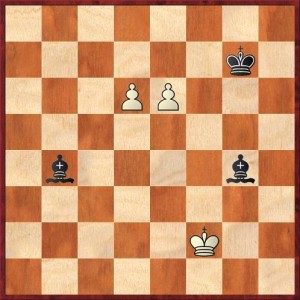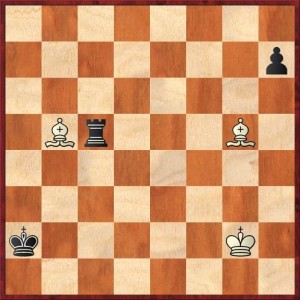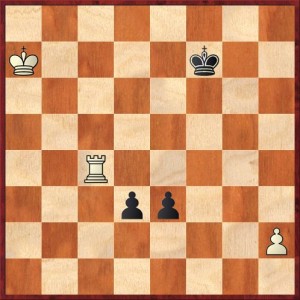This morning I had a really cool puzzle idea: Can you create a chess version of rock-paper-scissors?
To state the puzzle more precisely, I need to use the old-fashioned English Descriptive Notation, rather than algebraic. The advantage of English Descriptive — for this particular problem — is that it’s relative, rather than absolute: you describe the location of each player’s pieces from his own vantage point. For people unfamiliar with it, “K4” denotes, for example, the fourth square on that player’s king file, counting forward from his back rank. (Thus, one player’s K4 is the other player’s K5. This is the system I grew up with, so if you’re from a non-English country please don’t make snarky comments!)
So with that in mind, I want you to come up with three positions called Rock, Paper, and Scissors that list the location of one side’s pieces only. (For example: K on Q4, P on QN2, Q on KB7.) When one player has Rock and the other player has Scissors, Rock should win even if it’s Scissors’ move. (I’m adding this condition to make the problem harder.) Likewise, if one player has Scissors and the other has Paper, Scissors wins even if it’s Paper’s move. And finally, if one player has Paper and the other player has Rock, Paper wins even if it’s Rock’s move. And lastly, just to make it extra challenging, each side is only allowed three or fewer pieces.
Before I show you my solution, let me say a little bit about what motivated it. In mathematical terms, the puzzle is about a failure of transitivity. That is, Rock > Scissors and Scissors > Paper but Rock is not greater than Paper.
You can also get an interesting puzzle by asking for a failure of trichotomy. That would involve two positions A and B where A > B (i.e., A wins even if it’s B’s move) and B > A (i.e., B wins if it’s A’s move). That would be a mutual zugzwang. Such positions do exist; in fact, there was a chess novel call The Tower Struck by Lightning, by Fernando Arrabal, in which a subplot involves one player’s search for a mutual zugzwang. If memory serves me correctly, this mutual zugzwang position also serves as a metaphor for the real-life situation the characters find themselves in.
Ironically, there is a very simple mutual zugzwang (called the trebuchet) that involves just two kings and two pawns, and I imagine the character in the novel (a world championship candidate) would have known that. See the Wikipedia entry on zugzwang for this and more examples.
A final challenge would be to find a failure of reflexivity, a position where A > A. In other words, a symmetric position where the player who is on move loses. It’s easy to find positions where the player who is on move wins, but I strongly doubt that the opposite is possible.
Okay, here is my solution to the rock-paper-scissors puzzle.
Rock: K on KB2, P on Q6, P on K6
Paper: K on KN2, B on KN5, B on QN5
Scissors: R on QB4, K on QR7, P on KR2.
Here are illustrations of each of the three contests. In each case it is White’s move, and no matter what he does he loses.
Paper Covers Rock
FEN: 8/6k1/3PP3/8/1b4b1/8/5K2/8 w – – 0 1
Both of White’s pawns are under attack, so moving his king is too slow. If he pushes a pawn, one of the bishops will step in front of the other pawn and blockade them both. The other bishop will then pick them both up, and we will be in an elementary won endgame for Black.
Scissors Cut Paper
FEN: 8/7p/8/1Br3B1/8/8/k5K1/8 w – – 0 1
Here the two bishops are forked, and White has no checks that would work as an in-between move. If 1. Bd3 to attack the h-pawn, Black plays first 1. … Rxg5+ and then pushes the pawn. Finally, note that in all variations we end up with a R+P vs. B endgame that is won for Black. White can never win the pawn, because Black can put it on the opposite color to the bishop and put his rook on the square that the pawn protects. This will give Black time to get his king over to the kingside. Once that happens, the pawn cannot be stopped, and White cannot set up a stalemate position in the corner.
Rock Breaks Scissors
FEN: 8/K4k2/8/8/2R5/3pp3/7P/8 w – – 0 1
This one is the trickiest to analyze. We have a situation where White’s rook cannot stop Black’s two passed pawns. The question is whether he can still save a draw by capturing one of the pawns, allowing the other to queen, and moving his rook to a square where it defends that pawn (most likely along a rank). I designed the position in such a way that this defensive idea would be very unlikely to work. In order to defend the h-pawn White’s rook must be very far away from his king, and that means eventually Black will be able to set up a fork, or else White will be compelled to give up the pawn and enter a theoretically lost K+Q vs. K+R endgame.
However, there are lots of possible setups of the king, the rook, and the pawn. So just to make sure I was right, I plugged the position into the Nalimov tablebase (which gives 100 percent infallible evaluations of any position with 6 or fewer pieces) and sure enough, the position is a win for Black.
Let me know if you find any better solutions to the rock-paper-scissors puzzle! I do consider it a mild defect that it is hard to give an exhaustive analysis for the Rock-breaks-Scissors position.






{ 4 comments… read them below or add one }
After I posted this I realized that my analysis of the R+P versus B endgame was a bit too cursory. The Nalimov tablebase does show it as a win, but Black has to be careful not to advance his h-pawn too fast. There are some drawn positions in this ending. Black needs to get his king in front of the pawn and then try to pry White’s king away from the h-file.
A prototypical winning procedure occurs when Black gets White’s king into a “stalemate position” with the White king on h1, bishop on g1, Black king on h3, Black rook on the back rank (say, b1), and Black pawn on h4. Black then backs off, playing 1. … Kg4, in order to release White’s king. He then meets either 2. Kg2 or 2. Kh2 with 2. … h3 (+). If the king tries to stay on the h-file, with 3. Kh1, Black zugzwangs him with 3. … Ra1. Then 4. Kh2 is forced, and Black wins with 4. … Ra2+ 5. Kh1 Kg3 followed by 6. … h2.
I could probably have avoided all this trouble by putting the pawn on KN2 rather than KR2 in the “scissors” position, so that we don’t have any of the rook-pawn foolishness to contend with.
This link may be of interest: http://www.chesscafe.com/puzzling/puzzlerscup.htm
A final challenge would be to find a failure of reflexivity, a position where A > A. In other words, a symmetric position where the player who is on move loses. It’s easy to find positions where the player who is on move wins, but I strongly doubt that the opposite is possible.
I believe there was a Chess Life article where someone was creating these types of positions. It is definitely possible,
Thanks for sharing, this is a fantastic blog.Really thank you! Really Great.
{ 2 trackbacks }